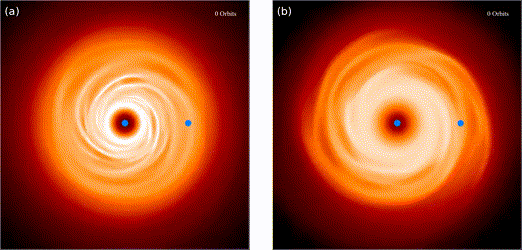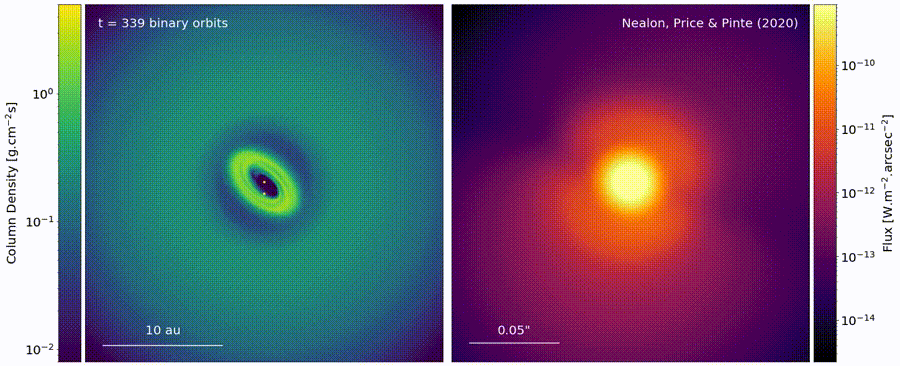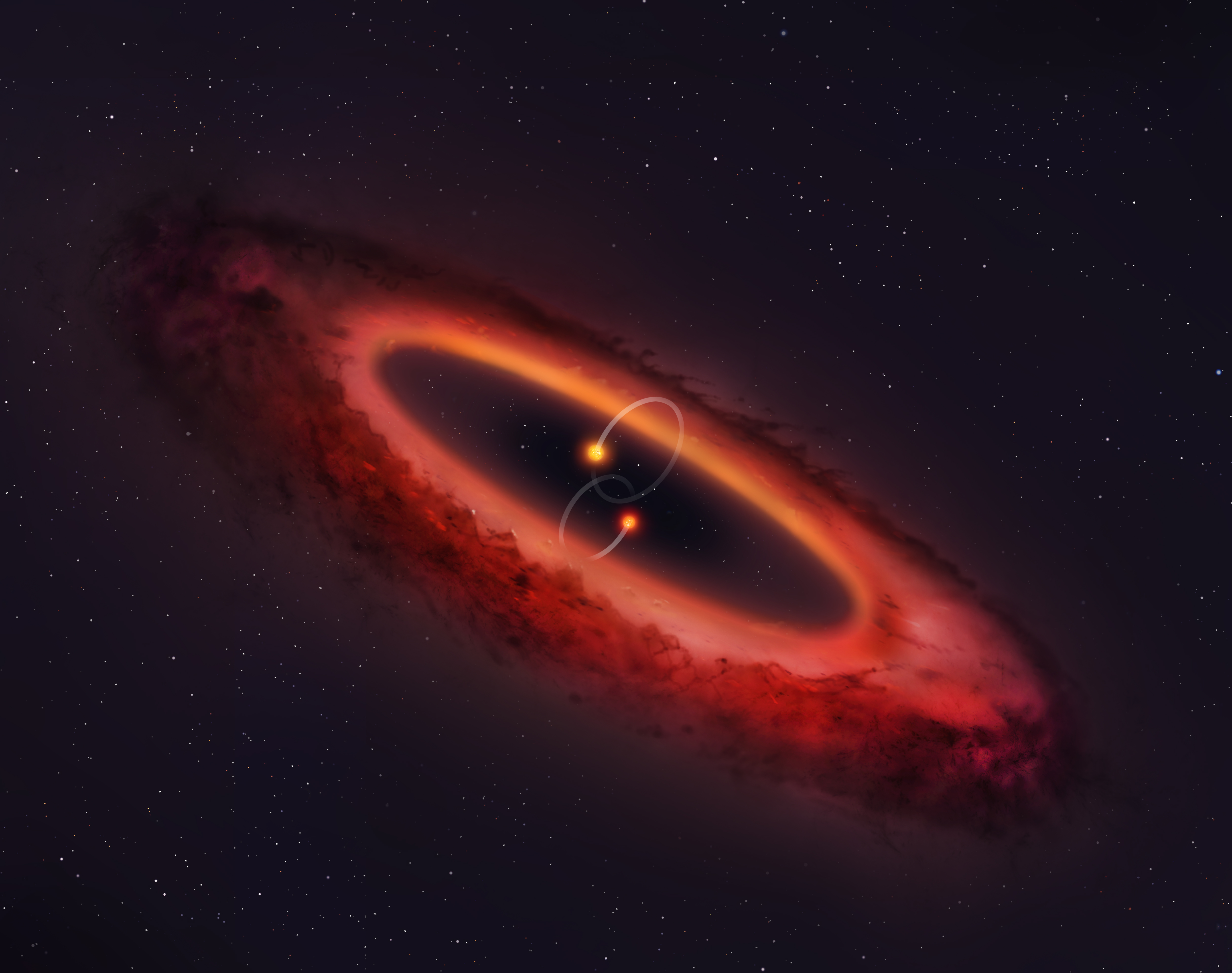Research News & Highlights
Spirals, shadows and precession in HD 100453 - II. The hidden companion
Rebecca Nealon, Nicolás Cuello, Jean-François Gonzalez, Gerrit van der Plas, Christophe Pinte, Richard Alexander, François Ménard, Daniel Price
 The protoplanetary disc HD 100453 exhibits a curious combination of spirals, shadows, and a relative misalignment between the observed outer disc and inferred inner disc. This disc is accompanied by a secondary star on a bound orbit exterior to the disc. In our companion paper, the orbit of the secondary was shown to be misaligned by 61° to the plane of the outer disc. Here, we investigate the properties of the inner companion and the origin of the misalignment between the inner and outer discs. In our proposed model, the misalignment observed between the outer and inner disc arises naturally as a result of the misaligned outer companion driving the outer disc to precess more rapidly than the inner disc.
The protoplanetary disc HD 100453 exhibits a curious combination of spirals, shadows, and a relative misalignment between the observed outer disc and inferred inner disc. This disc is accompanied by a secondary star on a bound orbit exterior to the disc. In our companion paper, the orbit of the secondary was shown to be misaligned by 61° to the plane of the outer disc. Here, we investigate the properties of the inner companion and the origin of the misalignment between the inner and outer discs. In our proposed model, the misalignment observed between the outer and inner disc arises naturally as a result of the misaligned outer companion driving the outer disc to precess more rapidly than the inner disc.
Planet Migration in Self-Gravitating Discs: Survival of Planets
Sahl Rowther, Farzana Meru

We carry out three-dimensional SPH simulations to study whether planets can survive in self-gravitating protoplanetary discs. The discs modelled here use a cooling prescription that mimics a real disc which is only gravitationally unstable in the outer regions. We do this by modelling the cooling using a simplified method such that the cooling time in the outer parts of the disc is shorter than in the inner regions, as expected in real discs. We find that both giant (> M_Sat) and low mass (< M_Nep) planets initially migrate inwards very rapidly, but are able to slow down in the inner gravitationally stable regions of the disc without needing to open up a gap. This is in contrast to previous studies where the cooling was modelled in a more simplified manner where regardless of mass, the planets were unable to slow down their inward migration. This shows the important effect the thermodynamics has on planet migration. In a broader context, these results show that planets that form in the early stages of the discs' evolution, when they are still quite massive and self-gravitating, can survive.
Rocking shadows in broken circumbinary discs

Rebecca Nealon, Daniel Price and Christophe Pinte
We use three dimensional simulations with coupled hydrodynamics and Monte Carlo radiative transfer to show that shadows cast by the inner disc in broken circumbinary discs move within a confined range of position angles on the outer disc. Over time, shadows appear to rock back and forth in azimuth as the inner disc precesses. The effect occurs because the inner disc precesses around a vector that is not the angular momentum vector of the outer disc. We relate our findings to recent observations of shadows in discs.
A circumbinary protoplanetary disk in a polar configuration
Kennedy, Grant M.; Matrà, Luca; Facchini, Stefano; Milli, Julien; Panić, Olja; Price, Daniel; Wilner, David J.; Wyatt, Mark C.; Yelverton, Ben M.
 Nearly all young stars are initially surrounded by 'protoplanetary' disks of gas and dust, and in the case of single stars at least 30% of these disks go on to form planets. The process of protoplanetary disk formation can result in initial misalignments, where the disk orbital plane is different from the stellar equator in single-star systems, or different from the binary orbital plane in systems with two stars. A quirk of the dynamics means that initially misaligned 'circumbinary' disks—those that surround two stars—are predicted to evolve to one of two possible stable configurations: one where the disk and binary orbital planes are coplanar and one where they are perpendicular (a 'polar' configuration). Previous work has found coplanar circumbinary disks, but no polar examples were known until now. Here, we report the first discovery of a protoplanetary circumbinary disk in the polar configuration, supporting the predictions that such disks should exist. The disk shows some characteristics that are similar to disks around single stars, and that are attributed to dust growth. Thus, the first stages of planet formation appear able to proceed in polar circumbinary disks.
Nearly all young stars are initially surrounded by 'protoplanetary' disks of gas and dust, and in the case of single stars at least 30% of these disks go on to form planets. The process of protoplanetary disk formation can result in initial misalignments, where the disk orbital plane is different from the stellar equator in single-star systems, or different from the binary orbital plane in systems with two stars. A quirk of the dynamics means that initially misaligned 'circumbinary' disks—those that surround two stars—are predicted to evolve to one of two possible stable configurations: one where the disk and binary orbital planes are coplanar and one where they are perpendicular (a 'polar' configuration). Previous work has found coplanar circumbinary disks, but no polar examples were known until now. Here, we report the first discovery of a protoplanetary circumbinary disk in the polar configuration, supporting the predictions that such disks should exist. The disk shows some characteristics that are similar to disks around single stars, and that are attributed to dust growth. Thus, the first stages of planet formation appear able to proceed in polar circumbinary disks.
